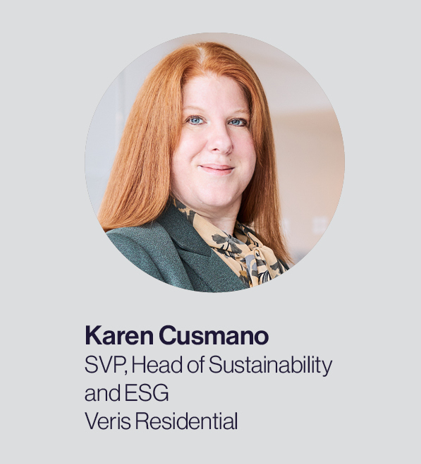Environmental, social and governance investing in multifamily assets
While all of the buildings that comprise a community have the potential to make a meaningful impact on residents’ day-to-day lives, there is arguably no space more influential than the home. Considering the sharp rental market rebound that has been underway since the latter half of 2021, multifamily assets are in a unique position to drive meaningful outputs through thoughtful improvements to ESG performance. However, with these opportunities come unique challenges specifically around benchmarking and reporting environmental and social performance metrics and progress.

Particularly in the wake of recent climate emergencies — that appear to be worsening terms in frequency and damage — it is crucial that we build sustainable, resilient and forward-thinking properties that residents feel safe and happy to call home. Looking to the future, there is ample opportunity for the multifamily sector to build actionable ESG strategies and tap into emerging trends to develop strong, innovative, sustainable multifamily communities that will stand the test of time. With this in mind, trailblazing owners and operators are driving forward sustainability goals by improving resiliency efforts, engaging with residents, and advancing reporting methodologies.
Recognizing the importance of continuous sustainable improvement in the multifamily sector, BREEAM recently invited a panel of industry experts to come together and discuss their perspectives and experiences, and to share insights on the future of ESG in the space
Panellists included:
- Karen Cusmano, SVP, Head of Sustainability and ESG at Veris Residential
- Eric Tilden, Senior Director of ESG at Elme Communities (formerly WashREIT)
- Anne Peck, Vice President, Head of ESG+R at TA Realty

Moderated by BRE’s US Director of Operations, Breana Wheeler, this discussion explored an array of top-of-mind themes including the sustainability goals that are most pressing for the multifamily market; challenges around data collection; the danger of greenwashing and the need for transparency in performance reporting; and evaluating resilience for multifamily assets. The panelists brought a variety of insights, anecdotes and experiences to the discussion, including:
One of the biggest challenges in advancing multifamily sustainability efforts is engaging residents and developing an effective approach to data collection:
“A big challenge with multifamily is that you aren’t dealing with controlled spaces. For the most part, we have to manage everything through our tenants,” shared Anne Peck. “[Tenants] control how much energy they use, how much water they use, what they do with their waste. It’s difficult for us to hit a net zero target for our assets when they control usage. In my opinion, that is the biggest differential between multifamily and other assets.”

“Data is one of those things that keep me up at night, especially when it comes to the Scope 3 emissions and the possibility of us reporting them within financial documents to the SEC in the future,” said Eric Tilden. “We have some communities, especially in rural areas, where the utilities are not set up to provide aggregated data and residents pay their own utility bills directly. We’re looking at metering technology and trying to encourage utilities to provide aggregated information where possible. We’ve also developed lease language to work with residents around data collection. It’s definitely one of the big challenges in some areas, and leads to the next challenge of taking that data and connecting with residents to actually drive change and reduce energy and water use in their homes.”
”In office [spaces], you have large tenants that may have their own sustainability targets, and it’s part of their values as a company – they make sure their employees are aligned with that. In multifamily, you can only encourage residents. In a lot of our buildings, residents pay gas and electric bills, so we don’t have transparency into usage,” said Karen Cusmano. “We have instituted metering on our resident usage. We can get aggregate data on what they’re using, though we don’t know individual units. New Jersey recently announced that we’re going to have to start benchmarking our buildings. Once that happens, and the laws are put in place, then the utility companies do need to provide us with the aggregate data…”
Resiliency initiatives are top-of-mind for multifamily asset owners and understanding climate data is essential to informing strategy:
“We do TCFD [(Task Force on Climate-related Financial Disclosures)] reporting; we have a resiliency program in-house that is part of our operations team; and we monitor climate risks through Moody’s 427 tool, as well as our ongoing programs like energy audits and assessments,” said Tilden. “We’ve implemented a robust resiliency program to review potential acquisitions, considering both physical and transitional risk. On top of a traditional property condition assessment, we complete an on-site climate resiliency and ESG assessment, pulling all sorts of data points from local municipalities. Every time we look at acquiring properties, ESG is a topic of conversation for our board of directors.”

“We started doing climate risk assessment this year. We’re putting together our climate risk program to be aligned with TCFD. It is really interesting trying to educate everyone in your own office, as well as at your assets,” shared Peck. “We’ve been talking about how quickly people can get back into a property if a climate event should happen. Once climate risk reports start becoming mainstream, then we can start having some kind of evaluation of what the return period is. We can start educating people as well, as to why something is implemented and how it’ll benefit them. Resilience itself is such a big topic and it is important to note that it has everything to do with getting the building back to running the way it was.”
“We use TCFD guidance on our properties to look at climate risks,” shared Cusmano. “We are making sure we’ve added to our property condition assessment. It’s a very hot topic at Veris Residential, and we do present it to our board through our ESG committee to keep everyone aware. This all has to be in our valuations that are coming and future capital expenditures. Of course, we’re always looking for ways to achieve this most efficiently for all of our stakeholders.”
To combat greenwashing, asset owners need to be transparent and show their work:
“In regards to greenwashing, your message needs to be clear and your progress needs to be measurable,” said Cusmano. “I think it’s important to be third-party certified. There are many organizations, like BREEAM, that do this. If you’re doing these things, you should be able to show your progress.”

“Be auditable. We’re connecting with groups like Deloitte and Ernst and Young to help with adding climate data to our financial filings given the proposed SEC requirements,” shared Tilden. “That level of scrutiny is going to have to happen. We’re starting to prepare the narratives around our process and program so that somebody who is completely independent of our organization can come in and say, ‘this makes sense.’”
“Our corporate sustainability report is still going through compliance,” Peck added. “We are making sure that our legal counsel has reviewed everything and that we’re not saying we’re doing anything that we’re not actually doing. Be ready for anyone to come and analyze everything in 150 different ways.”
If you missed the webinar, don’t worry! You can view the full panel recording here.
And if you want to hear more from BREEAM in the US and around the world, sign up for our newsletter to receive the latest news from our world-leading experts and access alerts about upcoming webinars and events.
BREEAM USA news
Browse other BREEAM USA news

Retail Market Breakdown: Sustainability Trends and Outlook

Opportunities and challenges for sustainable industrial assets

BREEAM publishes resource to support ENERGY STAR® users

Environmental, social and governance investing in multifamily assets

BREEAM USA takes part in GBES webinar on value of sustainable buildings

Opportunities and challenges for sustainability among retail assets

Navigating Sustainability: Insights from BREEAM and GRESB Leaders

BREEAM Champions DOE’s Net Zero Building Definition, Advancing Sustainable Practices for a Decarbonized Future

Experts Weigh In – Multifamily Market Breakdown: Sustainability Trends and Outlook

BREEAM New Construction Version 7 technical manual and summary of changes document

Key Takeaways from Climate Week NYC 2024

Championing Biodiversity for Real Estate

BREEAM USA experts on the pathway to carbon net zero in real estate

BREEAM USA's 2023 year in review: geographic and sector expansion drive robust certification growth

Unpacking ESG Upside with BREEAM and J.P. Morgan

BREEAM USA experts discuss a sustainable future for data center assets

BREEAM amplifies its presence in the U.S. by expanding capabilities

BREEAM announces partnership with EPA’s ENERGY STAR® program

BREEAM USA certifications grow by nearly 160% in 2022
Get in touch
Contact us now or call us on +14152981619 if you would like to talk to our team about how BREEAM can support you.
Return to BREEAM USA Homepage